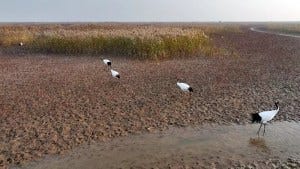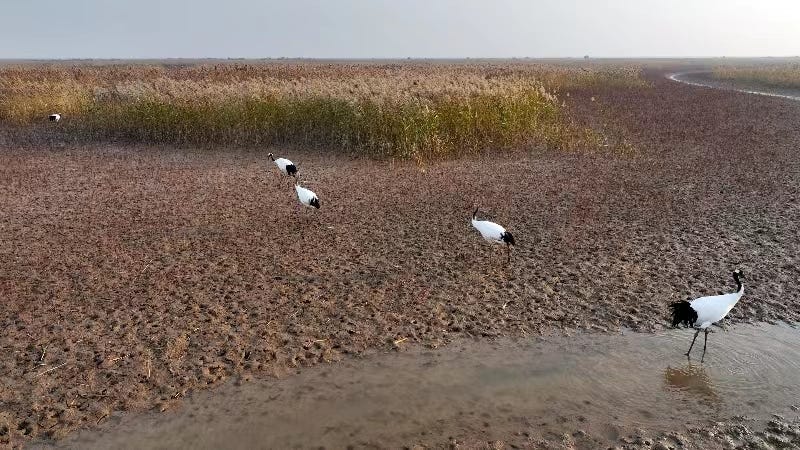Endangered storks nest in Chinese reserve as managers increase water flows
Endangered migratory birds are flocking to a Chinese nature reserve after managers quadrupled water flows from the Yellow River in recent years. The water allowed wetland vegetation to rebound, providing habitat for the bugs and animals that migratory birds love to eat.
Remote cameras have counted 198 oriental white stork nests this year at the Yellow River Delta National Nature Reserve in China’s Shandong province, according to Xinhua. The storks are listed as endangered under the International Union for Conservation of Nature (IUCN). Storks were first discovered nesting in the reserve in 2003. Rare red-crowned cranes have also been regular visitors to the reserve.
In the past two years, reserve managers have more than quadrupled the amount of water diverted from the Yellow River to the wetland. New channels are now delivering 175 million cubic meters (46 billion gallons) yearly.
“Water is the foundation of wetland ecosystems,” said Liu Jing, deputy director of the reserve’s management committee. “Only with water can plants thrive and the wetland vegetation be restored, providing food and shelter for birds.”
Reserve managers also restored 100 hectares (250 acres) of seagrass beds that were destroyed in a recent typhoon.
“The seagrass bed supports benthic organisms such as small fish and crabs, nutritious food for these birds,” said Zhou Licheng, the research chief with the reserve’s management committee.
One-third of the seagrass beds globally have disappeared due to climate change and human activities.
Known as an “international airport for migratory birds,” the reserve sees over six million birds pass through during the winter season. The reserve is 150,000 hectares in total (378,000 acres) and is adjacent to the Shengli Oil Field, China’s second largest oil producing region.
White storks were first spotted nesting in the reserve in 2003 but monitoring attempts scared them off. To reduce the risk of disturbing nesting activity, the reserve has built 66 surveillance cameras for birds, 75 for wetlands and over 40 for human activities.
“We used to count birds with our own eyes,” said Zhao Yajie, deputy director of the Yellow River Delta Environmental Monitoring Center. When she started working at the center, she would trudge through the mudflat wearing chest-high rubber waders, carrying binoculars, tripods, cameras and other heavy equipment. She would also live in remote management stations for several months at a time. Now, the cameras use artificial intelligence to identify species with 90 percent accuracy.
The reserve was established in 1992, at which time the oil field’s production facilities still overlapped with some areas of the reserve. In 2017, “environment monitoring groups sent by the central authorities noted that the reserve was a major wetland in Shandong and appropriate action should be taken to deal with the problem of some areas being taken over for oil production,” according to Xinhua. By 2020, 115 oil wells had been dismantled in the reserve.
* Editor’s note: This content is derived from Xinhua News Agency, the government news arm of the People’s Republic of China.
The post Endangered storks nest in Chinese reserve as managers increase water flows appeared first on EARTH HOPE.






